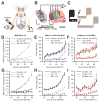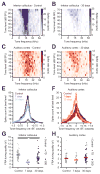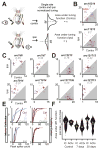Central Gain Restores Auditory Processing following Near-Complete Cochlear Denervation
- PMID: 26833137
- PMCID: PMC4760846
- DOI: 10.1016/j.neuron.2015.12.041
Central Gain Restores Auditory Processing following Near-Complete Cochlear Denervation
Abstract
Sensory organ damage induces a host of cellular and physiological changes in the periphery and the brain. Here, we show that some aspects of auditory processing recover after profound cochlear denervation due to a progressive, compensatory plasticity at higher stages of the central auditory pathway. Lesioning >95% of cochlear nerve afferent synapses, while sparing hair cells, in adult mice virtually eliminated the auditory brainstem response and acoustic startle reflex, yet tone detection behavior was nearly normal. As sound-evoked responses from the auditory nerve grew progressively weaker following denervation, sound-evoked activity in the cortex-and, to a lesser extent, the midbrain-rebounded or surpassed control levels. Increased central gain supported the recovery of rudimentary sound features encoded by firing rate, but not features encoded by precise spike timing such as modulated noise or speech. These findings underscore the importance of central plasticity in the perceptual sequelae of cochlear hearing impairment.
Copyright © 2016 Elsevier Inc. All rights reserved.
Figures








Comment in
-
The Ying and Yang of Auditory Nerve Damage.Neuron. 2016 Feb 17;89(4):680-2. doi: 10.1016/j.neuron.2016.02.007. Neuron. 2016. PMID: 26889808
Similar articles
-
The Ying and Yang of Auditory Nerve Damage.Neuron. 2016 Feb 17;89(4):680-2. doi: 10.1016/j.neuron.2016.02.007. Neuron. 2016. PMID: 26889808
-
Synaptopathy in the Aging Cochlea: Characterizing Early-Neural Deficits in Auditory Temporal Envelope Processing.J Neurosci. 2018 Aug 8;38(32):7108-7119. doi: 10.1523/JNEUROSCI.3240-17.2018. Epub 2018 Jul 5. J Neurosci. 2018. PMID: 29976623 Free PMC article.
-
Persistent Thalamic Sound Processing Despite Profound Cochlear Denervation.Front Neural Circuits. 2016 Aug 31;10:72. doi: 10.3389/fncir.2016.00072. eCollection 2016. Front Neural Circuits. 2016. PMID: 27630546 Free PMC article.
-
Audibility, speech perception and processing of temporal cues in ribbon synaptic disorders due to OTOF mutations.Hear Res. 2015 Dec;330(Pt B):200-12. doi: 10.1016/j.heares.2015.07.007. Epub 2015 Jul 15. Hear Res. 2015. PMID: 26188103 Review.
-
Central nervous system plasticity during hair cell loss and regeneration.Hear Res. 2000 Sep;147(1-2):145-59. doi: 10.1016/s0378-5955(00)00128-3. Hear Res. 2000. PMID: 10962181 Review.
Cited by
-
Evidence of degraded representation of speech in noise, in the aging midbrain and cortex.J Neurophysiol. 2016 Nov 1;116(5):2346-2355. doi: 10.1152/jn.00372.2016. Epub 2016 Aug 17. J Neurophysiol. 2016. PMID: 27535374 Free PMC article.
-
Neural signatures of auditory hypersensitivity following acoustic trauma.Elife. 2022 Sep 16;11:e80015. doi: 10.7554/eLife.80015. Elife. 2022. PMID: 36111669 Free PMC article.
-
Synergistic Transcriptional Changes in AMPA and GABAA Receptor Genes Support Compensatory Plasticity Following Unilateral Hearing Loss.Neuroscience. 2019 May 21;407:108-119. doi: 10.1016/j.neuroscience.2018.08.023. Epub 2018 Sep 1. Neuroscience. 2019. PMID: 30176318 Free PMC article.
-
Electrophysiological and Behavioral Evidence of Reduced Binaural Temporal Processing in the Aging and Hearing Impaired Human Auditory System.Trends Hear. 2018 Jan-Dec;22:2331216518785733. doi: 10.1177/2331216518785733. Trends Hear. 2018. PMID: 30022734 Free PMC article.
-
Age-related changes in excitatory and inhibitory intra-cortical circuits in auditory cortex of C57Bl/6 mice.Hear Res. 2023 Mar 1;429:108685. doi: 10.1016/j.heares.2022.108685. Epub 2022 Dec 27. Hear Res. 2023. PMID: 36701895 Free PMC article.
References
-
- Berlin CI, Hood LJ, Morlet T, Wilensky D, Li L, Mattingly KR, Taylor-Jeanfreau J, Keats BJB, John PS, Montgomery E, et al. Multi-site diagnosis and management of 260 patients with Auditory Neuropathy/Dys-synchrony (Auditory Neuropathy Spectrum Disorder) Int J Audiol. 2010;49:30–43. - PubMed
Publication types
MeSH terms
Substances
Grants and funding
LinkOut - more resources
Full Text Sources
Other Literature Sources
Research Materials

